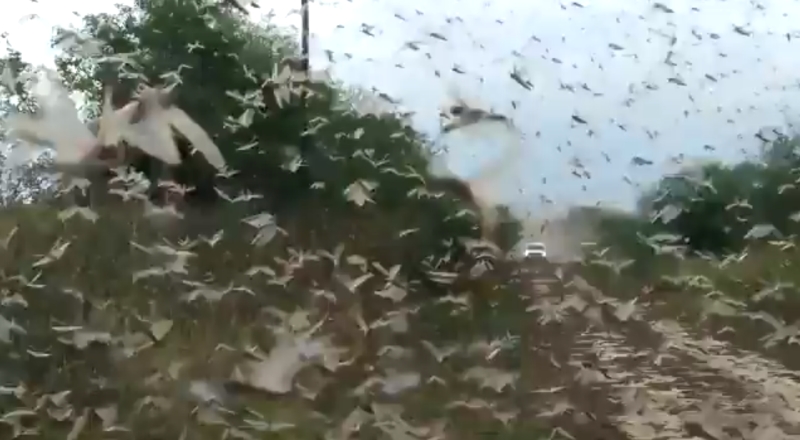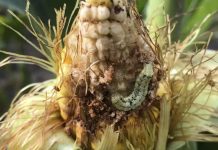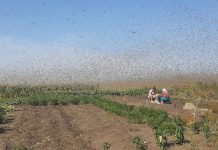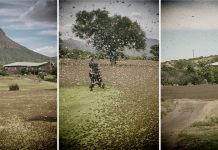Argentina is being invaded by a locust plague of biblical proportions, devouring everything on its path.
The biblical swarm of more than 40 millions of locusts has crossed from neighbouring Paraguay and is currently sweeping through the northern region of Argentina.

The short-horned grasshoppers have affected farms in the commune of Lanteri located in the northern Argentine province of Santa Fe after crossing from neighbouring Paraguay.
Videos taken by local residents show the terrifying scene as the insects completely block out the driver’s view on the road.
Plaga de langostas llega a Argentina: comen como 350.000 personas
— ????? ????????? ?. #QuedateEnCasa (@jravanales) June 19, 2020
Los voraces insectos provienen de Paraguay y tienen en alerta a los agricultores de la provincia de Formosa.
Los productos amenazados por estos insectos son los cultivos de mandioca, maíz, caña de azúcar. pic.twitter.com/1KDB2VjGHo
Motorists had to drive carefully as thousands of locusts flew past at a low altitude, hitting their windscreens.
Another clip captures the locusts sweeping through the regions in northern Argentina.
⚠️#Alerta #Langosta ? #SantaFe
— Senasa Argentina (@SenasaAR) June 18, 2020
Equipos #langosteros dieron apoyo a los productores del paraje El Algarrobal, del distrito de Lanteri, que realizaron acciones para disminuir la población de la manga de langostas. pic.twitter.com/hQwg9w5DLY
Lanteri community president Pipo Garcia told local media that the swarm is “astonishing” and that he has never seen anything like it.
From Paraguay
The swarms have passed through the Argentine provinces of Chaco and Formosa after crossing from Paraguay, according to reports.
The National Service of Agri-Food Health and Quality (SENASA) said the swarm was passing through the province of Chaco on Tuesday.
SENASA and several witnesses posted videos of the swarm of locusts on social media showing them filling the air over fields and roads in the region.
According to local media, they belong to a species of locust in the subfamily Cyrtacanthacridinae (Schistocerca cancellata) which have an insatiable appetite for crops of wheat, corn and oats used for cattle, but are different from the desert locust currently devastating Africa and SW Asia.
Yo lo anticipe, la plaga de langostas llego a corrientes, argentina. Muy pronto en bs as. pic.twitter.com/H0Mg9VKRMe
— Matias, así nomas. (@matii_ariel00) June 19, 2020
On Wednesday morning, the locusts reportedly passed through the municipalities of Villa Ocampo and Villa Guillermina in Santa Fe, travelling at around 100 kilometres (62 miles) a day.
Imágenes de la llegada de nubes de langostas a Lanteri, norte de Santa Fe, buscando campos para pasar la noche. pic.twitter.com/NPLaXKjhPX
— Martín Steeman (@MartinSteeman) June 18, 2020
SENASA said this swarm is capable of devouring the same amount of crops as 2,500 people per day.
Last month, the National Service of Vegetal Health of Paraguay informed SENASA about the presence of locusts on its border with Argentina.
Invasión de langostas en el Chaco, zona agua dulce en el Departamento de Alto Paraguay. ?? #LaNacionPy
— Diario La Nación (@LaNacionPy) April 11, 2020
?: Gentileza. pic.twitter.com/SinT2JUI6b
Meanwhile, Africa is facing a probable third wave of locust invasion in 6 months:
It’s clear that a famine is ahead… At least in those countries:
Crisis after crisis, the world and the human race will tumble apart! More biblical locust plague information on Strange Sounds and Steve Quayle. [Mega Noticias, Telam, Daily Star]













Not sure what any of that has to do with any of my prior comments or the article itself for that matter? Never claimed that “Locust plagues occur after a specific number of years” as you assert. If you’ll recall in my original comments I stated that while it’s “theoretically possible” the locusts could reach the plains states by harvest season. I emphasized it was “IMPROBABLE”
While I appreciate you sharing your impressive knowledge & expertise about locust’s migratory patterns and life cycles, none of all the information you’ve provided about locust’s migratory patterns & life cycles disproves any of the basic truths I’ve stated in my prior comments. I stand by them.
Traveling 62 miles a day it’s theoretically possible (though improbable) the locusts could reach the cornfields of Nebraska & Iowa by harvest season.
yes, but they need land they cannot cross the ocean…
I also believe they have a 5-7 month life cycle.
They’re in the western hemisphere! They already have all the land they require. Just migrate north through South America, Central America & Mexico!
Yes of course. My fault :-). My thoughts were in Africa and Asia where another locust plague is hitting right now too!
I wrote something about a US plague back in March 2020: https://strangesounds.org/2020/03/locust-palgue-devastates-usa-great-plains-video.html
Hopefully such an event won’t happen!
Because they’re so prolific, life cycle is irrelevant. A warm climate is all that’s required.
The life cycle is relevant.
Locusts are insects that are related closely to grasshoppers. All species of locust undergo three main life stages: egg, nymph and adult locust. Though all locusts go through the phases, the amount of time spent in each stage varies according to the specific species of locust. Only the adult stage can fly, swarm, and travel. I’ll give you a mystery: The life cycle of the Locust is mentioned as a time measurement in the Book of Revelation. That, and the life cycle of the Fig tree.
Their life cycles are not relevant to the subject matter of this article. Which is the crop destruction & ensuing famines they inflict. It is their prolific nature coupled with a conducive climate which gives them the ongoing ability to migrate many 1000’s of miles for months on end destroying & consuming everything in their path. Which is not limited or hindered by a brief life cycle.
There is no evidence that Locust plagues occur after a specific number of years. Instead, plagues develop intermittently. Mostly dependant on spring rains.
Major Locust plagues occurred in 1926-1934, 1940-1948, 1949-1963, 1967-1969 and 1986-1989.
A Locust lives a total of about three to five months although this is extremely variable and depends mostly on weather and ecological conditions. The life cycle comprises three stages: egg, hopper and adult. Eggs hatch in about two weeks (the range is 10-65 days), hoppers develop in five to six stages over a period of about 30-40 days, and adults mature in about three weeks to nine months but more frequently from two to four months.
April and May rains determine the size of locust swarms. By October most swarms are already gone.
Desert Locusts must fly with the wind at a speed of about 16-19 km/h depending on the wind speed. Swarms can travel about 5-100 km or more in a day. Locusts can stay in the air for long periods of time. For example, locusts regularly cross the Red Sea, a distance of 300 km.
Solitary Desert Locust adults usually fly at night whereas gregarious adults (swarms) fly during the day.
Locust swarms can vary from less than one square kilometre to several hundred square kilometres. There can be at least 40 million and sometimes as many as 80 million locust adults in each square kilometre of swarm.
In 1988, a very rare occurance happened. West Africa locust swarm travelled on the winds across the Atlantic Ocean to the Caribbean, a distance of 5,000 km in about ten days.
I am a Degreed Scientist. Over the years I have caught a lot of locusts.
Indeed it has all just begun! Be prepared and get ready!
The fun has only begun, Gentiles and their co-horts whom are confederate against the Most High’s chosen seed.
Don’t forget the synagogue of Satan.
YHWH is Satan.
I bet he told you!